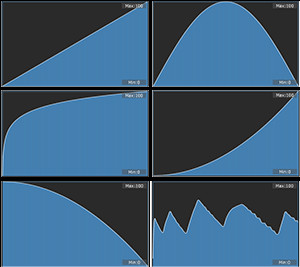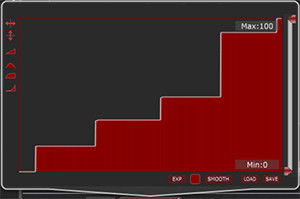For guitarists seeking to dynamically manipulate their sound and explore a wider sonic palette, the Expression Guitar Pedal is an indispensable tool. Building upon the insights of fellow players, let’s delve into how these pedals can revolutionize your playing, particularly when integrated with software plugins, offering unparalleled control and creative possibilities.
Expression pedals, like the robust and reliable EV-30 praised for its durability and versatile settings, or the more travel-friendly EV-5, provide a hands-free method to control parameters of effects pedals and plugins in real-time. While hardware connections offer tactile immediacy, the digital realm opens up a universe of customization and flexibility, especially for guitarists working within a plugin-based setup.
 Customizable expression pedal curve in a plugin, showing precise control over guitar effects parameters.
Customizable expression pedal curve in a plugin, showing precise control over guitar effects parameters.
One of the most significant advantages of using expression pedals in a digital audio workstation (DAW) or plugin environment is the ability to reshape the control curve. This means you can tailor the pedal’s response to perfectly match your desired effect. For instance, you can create a curve that allows for subtle, gradual changes across the pedal’s sweep, or design a more dramatic, immediate response in specific ranges. This level of precision is invaluable for sculpting nuanced and dynamic guitar tones.
Consider the application of an expression pedal to control a rotary effect. By carefully shaping the pedal’s range curve, you can configure it to smoothly transition between slow and fast rotary speeds, and even introduce a ‘stop’ position within the pedal’s travel. This allows for seamless and intuitive manipulation of the effect directly with your foot, freeing your hands to focus on playing.
Beyond continuous parameter control, expression pedals can also be used for stepped parameter changes, effectively turning them into preset selectors. Imagine using an expression pedal to switch between different synth presets or effect configurations. By implementing a ‘staircase’ curve, each step of the pedal’s movement can trigger a distinct preset recall. This opens up exciting possibilities for live performance and studio experimentation, enabling on-the-fly sound transformations.
 Staircase expression pedal curve used for stepped preset changes, ideal for synth and effect switching.
Staircase expression pedal curve used for stepped preset changes, ideal for synth and effect switching.
The true power of the expression guitar pedal lies in its capacity to control multiple parameters simultaneously. Imagine assigning a single pedal to adjust flanger depth, amp drive, and delay time concurrently. This allows for the creation of complex and evolving soundscapes that would be impossible to achieve with static settings. From subtle textural shifts to dramatic sonic transformations, the only limit is your imagination.
In conclusion, the expression guitar pedal transcends its simple hardware form to become a gateway to profound sonic exploration. Whether you favor the tactile feel of hardware pedals or the boundless flexibility of plugins, incorporating an expression pedal into your setup unlocks a new dimension of real-time control and creative expression for guitarists of all styles and genres. Embrace the power of the expression pedal and discover the vast potential it holds for shaping your unique guitar voice.
